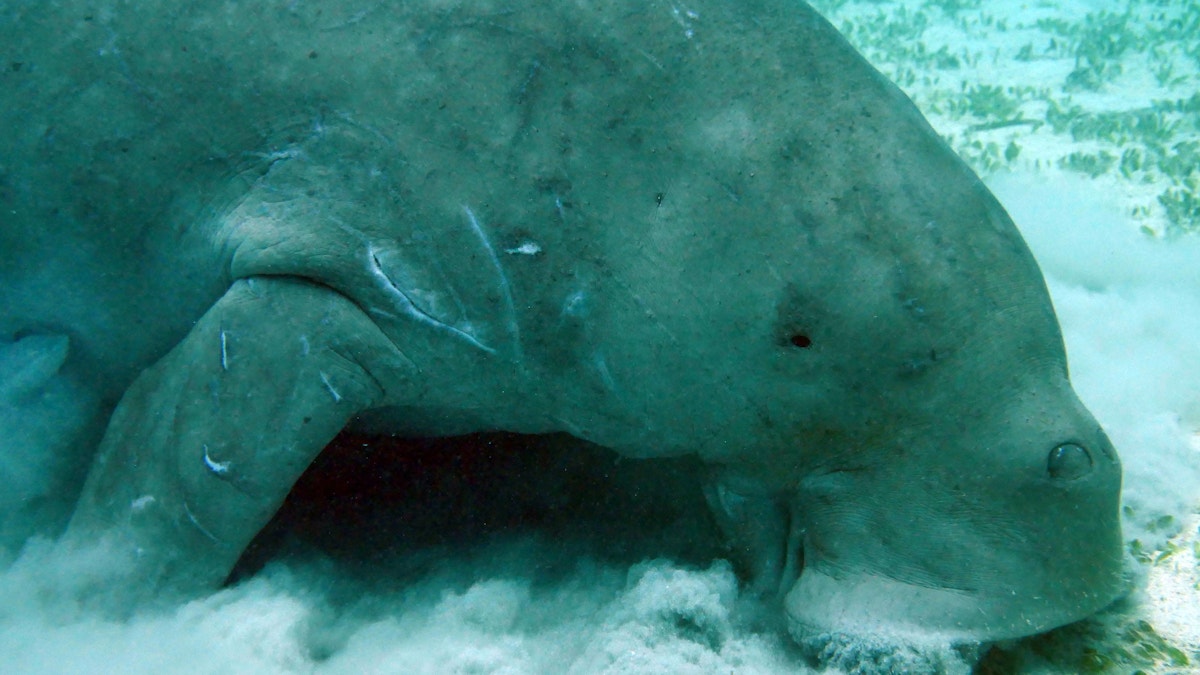
Dr Dazza | All about Dugong
Published 5:00am 3 November 2022

 Words by Kylie Knight
Words by Kylie Knight
Dugong are often commonly referred to as ‘sea cows’, although they are not related to cows at all. They are also not closely related to dolphins or whales.
Dugong are members of the mammalian order Sirenia, and the closest living relatives of the group are the elephants and hyraxes. The latter are a group of small herbivorous mammals found in sub-Saharan Africa and the Middle East.
Australia’s dugong population is globally significant, and Moreton Bay supports the largest dugong population near a major city anywhere in the world. The density of dugong is high in Moreton Bay compared to other locations along Queensland’s east coast.
The Moreton Bay dugong population is at the southern end of the species’ range and geographically isolated from the next population to the north in Hervey Bay and the Great Sandy Straits. There is evidence that the dugong population in Moreton Bay is genetically different from the populations further north. Dugong are occasionally recorded further south, but they do not form stable populations at latitudes south of Moreton Bay.
Where to find them
Work from the University of Queensland showed that within Moreton Bay, Amity and Moreton Banks support consistently high numbers of dugong with two ‘hot spots’ within this area being the western Maroom and northern Coonungai Banks.
The southern part of Pumicestone Passage provides year-round habitat for the next most significant concentration of dugong in Moreton Bay. Dugong also occur in low numbers in locations such as the channels and banks associated with the southern bay islands (Macleay, Russell, Lamb and Karragarra Islands), St Helena Island, and Waterloo and Deception Bays.
Dugong consume seagrass and can eat between 10-15 per cent of their substantial body weight each day. They are highly selective in terms of the seagrass species they prefer to consume. They prefer low biomass stands of various pioneering species rather than the dense stands of ‘eelgrass’.
It is the roots of the seagrass that is of nutritional value to the dugong rather than the leaves. The feeding activity of dugong creates distinct feeding trails on the seabed. Healthy seagrass beds are critical for maintaining healthy dugong populations.
Dugong can live up to 70 years and females reach reproductive maturity between 6 and 17 years. They produce a single calf after a 14-month gestation period every 2–2.5 years. The tiger shark is thought to be their most significant natural predator.
Dugong are culturally important for Indigenous Australians along the Queensland coastline.

Dugong hunting
Commercial dugong hunting commenced in Moreton Bay in 1847 at Amity Point and continued intermittently until 1969, although most activities had largely ceased by 1920. Dugong were hunted commercially in Moreton Bay for their oil, which was reputed to have various medicinal benefits, as well as being useful for cooking and for cosmetics.
Furthermore, dugong hides were used to manufacture leather products, the bones were used to produce ornamental cutlery handles, and meat was readily sold in Brisbane. A dedicated dugong fishing station was established on St Helena Island in 1856 and this location, along with the one at Amity Point, was the focus of the hunting efforts in Moreton Bay. Commercial dugong harvesting continued intermittently until 1969, although most activities had largely ceased by 1920.
Unlike dolphins and whales, dugong are frequently hard to spot, but keep an eye out around the seagrass beds in Moreton Bay and you might be lucky enough to spot one!
Related Stories
Top Stories

Info sessions for North Pine dam
Drop-in community sessions are being held over the next nine days for those wanting more information about Seqwater’s dam improvement program.


Popular Stories

Moreton Bay artists shine in 2024 Brisbane Portrait Prize
Four Moreton Bay artists are among the 64 finalists chosen from almost 600 entries in this year’s Brisbane Portrait Prize. See their works...

'Priority' given for Waraba plans
Waraba, formerly known as Caboolture West, will be the 36th Priority Development Area in Queensland, unlocking land for 30,000 new homes and an estimated 70,000 new residents.

Trai Fuller: ‘It’s always felt like home’
Praised by Wayne Bennett for his courageous style of play and loved by long-time Dolphins fans, Trai Fuller has locked in a two-year deal with the club he calls home. He tells us why it means so much to him













